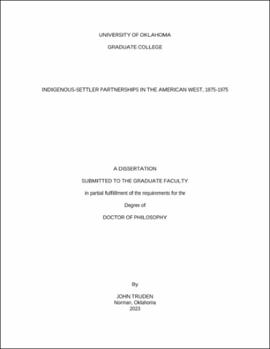| dc.description.abstract | Between Reconstruction and the early Cold War, Indigenous communities in Oklahoma faced an existential crisis. Over the course of the nineteenth century, the United States applied intense pressure on Indigenous communities in the path of US settlers to relocate to Indian Territory, an unincorporated US territory at the center of the continent. US officials offered the “promise” – as US Supreme Court Justice Neil Gorsuch famously termed it in his groundbreaking opinion for McGirt v. Oklahoma (2020) – that Indian Territory would be Indigenous land forever. In 1889, those same officials reversed themselves and began opening parts of the territory to American settlers. Faced with disaster and bereft of resources, many Indigenous people formed strategic relationships with White settlers to survive and thrive in an otherwise hostile environment. Drawing stories and perspectives from Comanche, Southern Cheyenne, Cherokee, Absentee Shawnee, Choctaw, Seminole, Kanza, Citizen Band Potawatomi, Chickasaw, Mvskoke (Muscogee Creek), Mississippi Choctaw, Sac and Fox, Kiowa, Plains Apache, Kansas Kickapoo, and Prairie Band Potawatomi communities, this dissertation follows a suppression and resurgence of Indigenous sovereignty across Reconstruction, the Gilded Age, the Progressive Era, the 1920s, the Great Depression, World War II, the early Cold War, and finally the Red Power era. Over this broad swath of time, Indigenous-settler relationships varied in scope and scale, evolved, and were shaped by race, class, gender, and a host of other factors. Gradually, these partnerships became more sophisticated and involved larger groups of people. Still, Indigenous-settler relationships were never ideal; Indigenous people formed ties with White settlers as a stand in solution after the federal government suppressed their systems of self-governance during Reconstruction. Until they were able to rebuild their tribal governments, they did the best they could with the resources that they had. With the assistance of their allies, Indigenous communities in Oklahoma revitalized their governments from the 1970s onward but retained a skillset of making alliances. | en_US |

